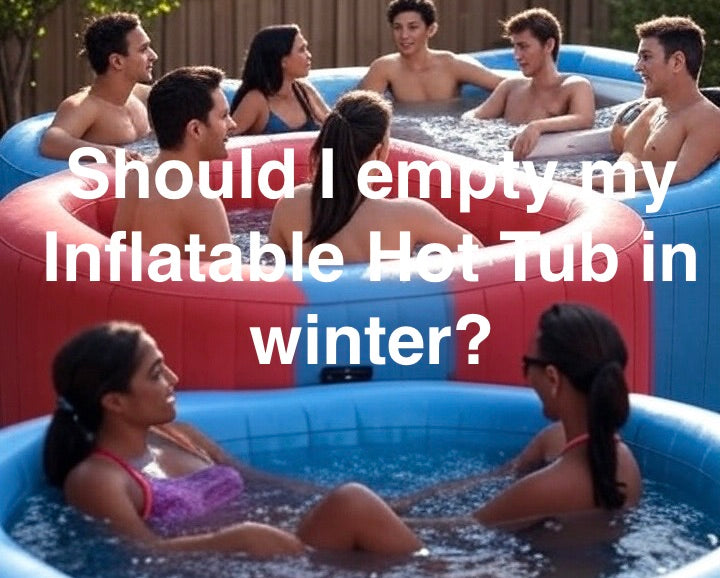
Should You Empty Your Inflatable Hot Tub for Winter?
Let’s be honest—nobody buys an inflatable spa dreaming about standing outside in January, chipping ice off the cover and checking chlorine levels with frozen fingers.
So, should you empty your inflatable hot tub for winter? Yes—most of the time, draining and storing it is the smartest move, especially if you live where temperatures dip below freezing.
Why Storing Your Hot Tub is the Smart Choice

Preventing Freeze Damage
Water and freezing pipes are a terrible combination. If water freezes inside your pump or filter, it expands and can crack them wide open. Once that happens, repairs are often pricier than buying a brand-new tub.
Protecting the Vinyl and PVC
Cold makes vinyl and PVC brittle. A material that’s soft and flexible in summer can suddenly split or tear when exposed to frost. One crack in the wall of your spa, and it’s game over.
Saving Money and Energy
Inflatable heaters aren’t designed to battle snowstorms. Running one constantly in freezing weather sends energy bills sky-high. Storing your spa saves you a fortune.
Avoiding Winter Maintenance
When your tub is tucked away, you’re not outside balancing chemicals, scooping ice, or checking whether the pump survived another cold snap. It’s stress-free—and your future self will thank you.
A Step-by-Step Guide to Winterising Your Inflatable Hot Tub
Clean and Drain Thoroughly
Don’t just pull the plug and walk away. Empty the water completely, scrub the interior with a mild detergent, and remove any leaves, dirt, or build-up.
Dry Every Component Completely
A damp corner left unchecked can turn into mould—or worse, frozen damage. Wipe every part, from the liner to the pump, until bone dry.
Deflate and Fold with Care
Rushing this step is how people end up with creased or punctured liners. Take your time, follow the manufacturer’s folding guide, and pack it away gently.
Choose the Right Storage Location
The garage, loft, or a clean indoor shed is ideal. Keep it dry, away from sharp objects, and out of extreme cold. If pests are a problem, use a sealed storage bag.
When It Might Be Possible (and What to Know)

Climate Considerations
If you live somewhere mild where winter barely brushes freezing, you might just get away with year-round use. But if your garden looks like Narnia from November to February, it’s not a good idea.
Hot Tubs with "Freeze Shield" Technology
Some modern spas come with anti-freeze or “freeze shield” tech. They’re better equipped for cold weather, but they’re not magic. You still need to keep an eye on them.
The Cost and Effort
Think higher electricity bills, constant monitoring, and more frequent chemical checks. The tub doesn’t care that you’re busy or it’s snowing—it needs daily attention.
Best Practices for Year-Round Use
Maintain a Constant Temperature
You can’t turn the heater off. Keep it running around the clock to stop water freezing inside pipes. It’s pricey, but essential.
Use a High-Quality Insulated Cover
This is your secret weapon against energy loss. A snug, insulated cover traps heat, stops frost forming on the surface, and reduces running costs.
Keep the Water Chemically Balanced
Cold water reacts differently to treatments, so test it regularly. Staying on top of the balance avoids cloudy water and keeps bacteria at bay.
Protect from the Elements
Snow, rain, and wind can all make your tub less efficient. Put it under a gazebo, awning, or covered patio for extra protection.
Final Verdict: The Best Decision for Your Hot Tub

For most people, the best move is simple: drain, clean, and store your inflatable spa for winter. It’s cheaper, safer, and prevents the heartbreak of pulling your tub out in spring only to find it’s cracked.
If you’re in a mild climate or have a tub with built-in freeze protection, you might keep it running—but be prepared for the bills and effort.
Protect your investment, save yourself the stress, and look forward to a fresh, trouble-free soak when the sunshine returns. Winterise wisely, and your inflatable spa will thank you.
Have you checked out our other posts?
Can Inflatable Spas Be Used In Winter?
What Temperature Should I Keep My Inflatable Hot Tub When Not In Use?
Do Inflatable Hot Tubs Get Hot Enough?
How Long Do Inflatable Spas Take To Heat Up?
How Long Can Water Stay In An Inflatable Hot Tub?



Leave a comment